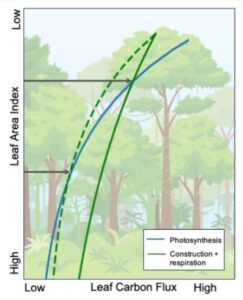Field-based Canopy Gradients in Leaf Respiration Improve Modeled Canopy Structure Scientists reduced bias in simulated forest dynamics by updating model assumptions to align with field observations.

Image courtesy of Jessica Needham, LBNL.
Steeper canopy gradients of leaf maintenance respiration (dashed line) based on field measurements changes the point in which leaves are in negative carbon balance which impacts allocation of carbon to leaf biomass.
The Science
Around half of all carbon that plants take up through photosynthesis is released back to the atmosphere by plant respiration. Despite its importance as a major component of the carbon cycle, most Earth system models represent plant respiration very simply. Scientists from the Next Generation Ecosystem Experiments Tropics project updated assumptions in the DOE’s earth system model about how respiration changes from sunlit leaves at the top of the canopy to shaded leaves deep in the forest understory based on measurements from a field site in Panama. Global simulations with the updated model were a better match to observations of forest structure.
The Impact
Leaf area index, a measure of the amount of leaf area in the forest canopy per unit ground area, is an important forest attribute, driving exchanges of carbon, water and energy between the land and atmosphere through impacts on photosynthesis and evapotranspiration. By updating model assumptions based on field observations, scientists were able to improve modelled leaf area index. This will further our understanding of the role of forests in the Earth system over the coming decades.
Summary
When field scientists from the NGEE-Tropics project found that vertical gradients in leaf respiration differed from model assumptions, scientists from the modelling team responded by updating the ELM-FATES model to align with observations. When respiration has a steeper canopy gradient and is lower in the understory, leaves deeper in the canopy remain in positive carbon balance, with more carbon taken up by photosynthesis than is used in leaf construction and respiration. As a result, plants grow more leaves, which increases simulated rates of photosynthesis and evapotranspiration. The updated parameterization of ELM-FATES led to an increased number of understory plants, and higher leaf area index, both of which improved alignment of simulations with ground and satellite observations.
Contact
Jessica Needham
Lawrence Berkeley National Laboratory
jfneedham@lbl.gov
Funding
This research was supported as part of the Next Generation Ecosystem Experiments-Tropics, funded by the U.S. Department of Energy, Office of Science, Office of Biological and Environmental Research and as part of the Energy Exascale Earth System Model (E3SM) project, funded by the U.S. Department of Energy, Office of Science, Office of Biological and Environmental Research Earth Systems Model Development Program area of Earth and Environmental System Modeling. LBNL is managed and operated by the Regents of the University of California under prime contract number DEAC02-05CH11231. R.F. also acknowledges support of the EU Horizon2020 under grant agreement 101003536 (ESM 2025).
Publications
For each publication, link to the publication’s record in DOE Pages in OSTI (https://www.osti.gov/pages/) in the title of the article. This is now required for all research funded by DOE. The researcher submitting the highlight will need to first submit the accepted manuscript of the journal article(s) to the DOE Office of Scientific and Technical Information (OSTI) via the DOE Energy Link System (E-Link). If the researcher is a financial assistance awardee, they can submit a completed DOE Announcement Notice (AN) 241.3 by going to: https://www.osti.gov/elink-2413. In the case of lab researchers, they will need to consult with their lab’s STI Manager for more information about submission. A listing of STI Managers can be found here: https://www.osti.gov/stip/stimanagers#stimanagers.
Needham, J. F., et al, “Vertical Canopy Gradients of Respiration Drive Plant Carbon Budgets and Leaf Area Index.” New Phytologist, (2025). [DOI: 10.1111/NPH.20423]
Lamour, J., et al. “The Effect of the Vertical Gradients of Photosynthetic Parameters on the CO2 Assimilation and Transpiration of a Panamanian Tropical Forest.” New Phytologist 238 (6), 2345–62 (2023). https://doi.org/10.1111/nph.18901.